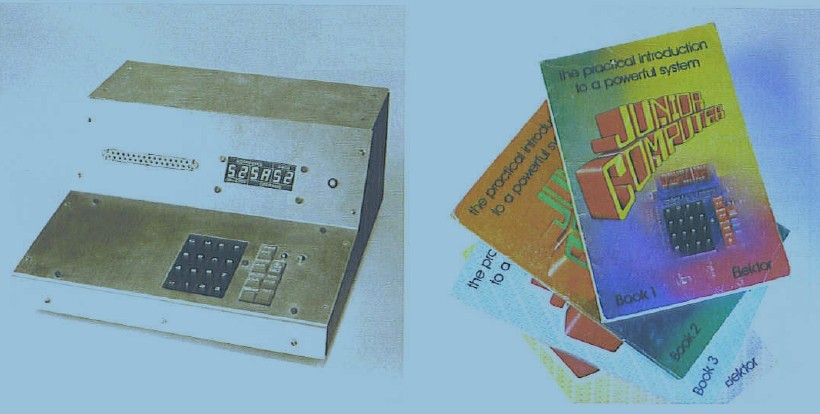

Project Solutions
Elektor Junior Computer
Published:2011/8/18 1:23:00 Author:Li xiao na From:SeekIC
By Jan Buiting 
Although the Elektor Junior computer was not the first home-built computer based on the 6502 processor (the KIM and others having achieved spectacular results in the USA) it did become a legendary design with PCB sales in the thousands. The original Junior Computer v/as designed by Lois Nachtmann and Gerard Nachbar burning midnight oil in a special ’computer room’ within the Elektor design lab.
Curiously, when the first Junior computer articles started to appear in Elektor May 1 980, the use of ’new-fangled’ technology like a microprocessor was heavily criticized particularly by readers of the English-language edition of Elektor. This was to change within months, however, as the ’JO design matured in near-exponential fashion with no competition from other UK publications and several authors from all over the world jumping the bandwagon by making significant contributions to the Junior hardware and software. The ’digibits’ were on the loose and as it turned out there was no stopping them.
Dinosaur Junior
The Junior computer is an expandable system based on The MOS Technology 6502 microprocessor, which is attached to 1 K ROM (2708 EPROM) and 1 K RAM (2 x 2114) yes that’s 0.000001 Gigabytes. The ’bare’ Junior was programmed in hexadecimal words for instructions, addresses and databytes. A ROM-based monitor, a keyboard and a compact display allowed programs and data to be entered and manipulated. Assembly code came later when the JC was attached to a terminal. Such upgrades did require more RAM and ROM, of course. The magazine came up with the goods by publishing DIY memory expansion cards. Expensive it was, though, o fully loaded 4 K RAM PCB setting you back by an amount equivalent to buying two 128-MB Flash USB memory slicks today.
Although the Junior computer may appear extremely primitive in this day and age of DSP MPUs ticking at Gigahertz frequencies, we are sure that many readers have fond memories of running their first ’LED on/off’ and ’you-press-l-beep’ programs on the Junior and showing them off to family members.
Open-platform
A remarkable thing about the junior computer, as compared with many other projects published since the mid-1970s, is that it drew in lots of contributions from readers —specifically, 6502 software making clever use of the (scarce) hardware resources or allowing the Junior to communicate with the real world. Examples include a 6502 system monitor, an assembler, a magnetic tope interface, a floppy disk interface and to cap it all, adapted BASIC! One Junior computer was specially built and adapted for use as o system by our own Software Service at o programmer time when bipolar PROMs like the 82S23 and 82S123 were used in Elektor projects. The system proved utterly reliable and supplied hundreds of PROMs before a more versatile programming system was obtained.
Books and Paperware
Software, hardware, spyware, bloatware, vapourware, whatever next? In the early 1980s, Elektor made a wise move to bundle all published articles on the Junior computer into four magnificent books and four cut-price Paper-vote editions resembling stencilled college curricula. Paperware 1-4 are now collector’s items not for their content or low print run we guess, but because not looking like ’books’ they gprogrammerot thrown away easily in house and office moves (including our own!).
Our thanks are due to Mr Dennis Fitzpatrick for porting with his JC bare beard.
Says Dennis: "Great little computer, never bothered to do the expansion stuff but I learned a lot. One leg or the board was always missing, I used to use an eraser to balance the board and just got used to it, I suppose’".
Reprinted Url Of This Article: http://www.seekic.com/blog/project_solutions/2011/08/18/Elektor_Junior_Computer.html
Print this Page | Comments | Reading(2473)
Article Categories
New published articles
· Imagination works with TSMC to develop FinFET process
Author:Ecco Reading(46227)
· XMOS pushes event-driven MCUs with lower price
Author:Ecco Reading(4146)
· Intel brings upgraded 32-nm SoC for smartphones
Author:Ecco Reading(3873)
· Micron pushes TLC 128-Gbit NAND flash
Author:Ecco Reading(4619)
· Intel will stop supplying desktop motherboards
Author:Ecco Reading(5969)
· Processor market was expected to regain strength in 2013
Author:Ecco Reading(3962)
· It was reported that TSMC sales fall steeply
Author:Ecco Reading(3626)
· Cisco, NXP work with auto wireless startup
Author:Ecco Reading(4288)
· Micron was impacted by manufacturing glitch
Author:Ecco Reading(4652)
· China can make 22-nm transistor by themselves
Author:Ecco Reading(4490)
· Chip market rebound is coming, according to survey
Author:Ecco Reading(4393)
· Sony, Toshiba will spend more on chips, iSuppli reports
Author:Ecco Reading(3957)
· Qualcomm becomes the 13th company to join NFC Forum board
Author:Ecco Reading(6798)
· TSMC increases building work for FinFET fab
Author:Ecco Reading(4472)
· TI plans to cut 1,700 jobs in OMAP shift
Author:Ecco Reading(5348)